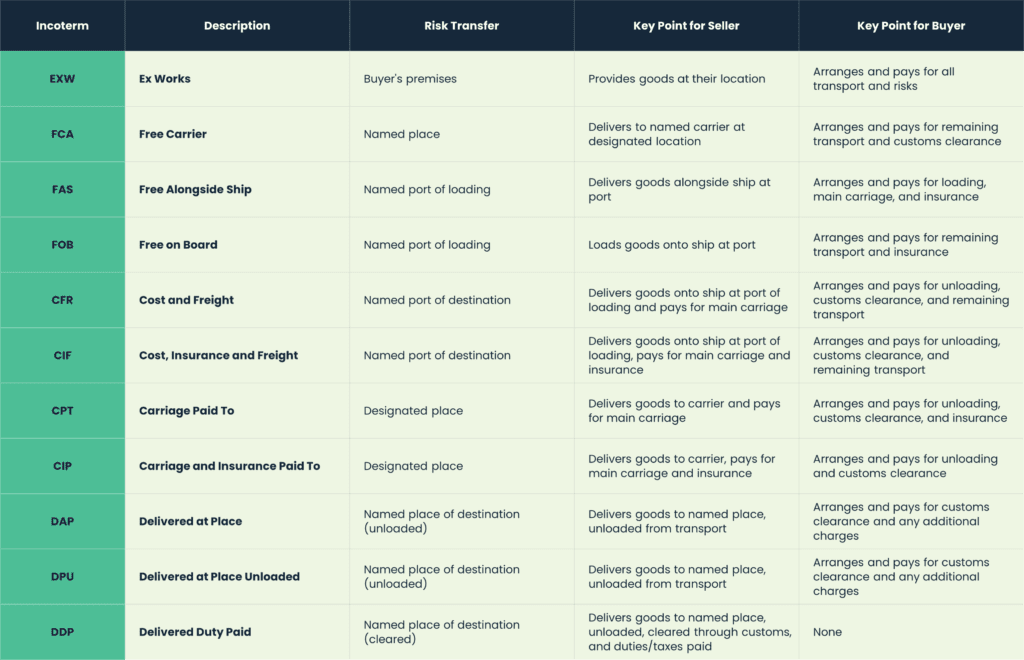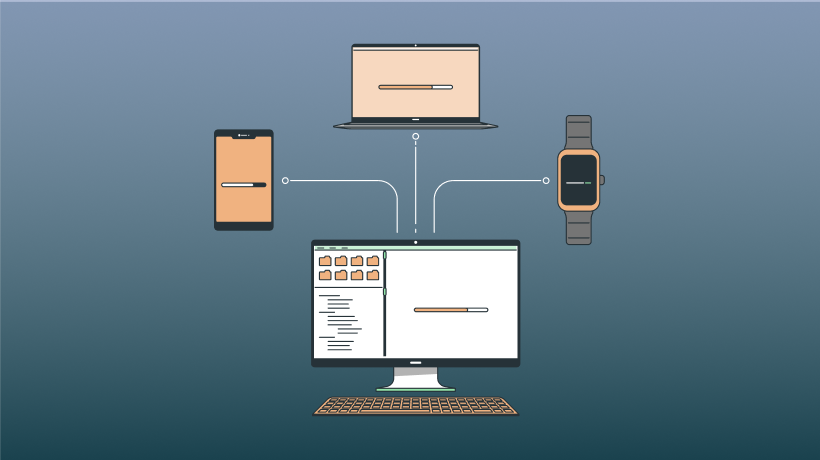

The world of international trade is a complex landscape, filled with diverse regulations, varying logistics practices, and potential uncertainties. For procurement and supply chain professionals, navigating these complexities is crucial for ensuring efficient and cost-effective operations. In this intricate dance, Incoterms (International Commercial Terms) play a vital role in establishing clear lines of responsibility and minimizing risks.
What are Incoterms?
Developed by the International Chamber of Commerce (ICC), Incoterms are a standardized set of 11 internationally recognized trade terms that define the division of responsibilities, costs, and risks between buyers and sellers in international transactions. These terms serve as a common language for negotiating and agreeing upon crucial aspects of a sale, such as:
- Delivery point: Where does the seller’s responsibility for the goods end and the buyer’s begin?
- Transportation costs: Who pays for the different legs of the journey (e.g., loading, unloading, main carriage)?
- Risk transfer: When does the risk of loss or damage to the goods shift from the seller to the buyer?
- Customs clearance: Who is responsible for clearing the goods through customs at each border crossing?
Why are Incoterms important in Procurement & Supply Chain?
Understanding and applying Incoterms effectively offers several benefits for procurement and supply chain professionals:
- Clarity and transparency: Incoterms eliminate ambiguity in contracts by clearly outlining each party’s obligations, leading to smoother and more efficient transactions.
- Risk mitigation: By understanding the transfer of risk at each stage, both buyers and sellers can take appropriate measures (e.g., insurance) to minimize potential losses.
- Cost control: Clear delineation of responsibilities allows for accurate calculation of landed costs (total costs delivered to the final destination), enabling better budget planning and pricing strategies.
- Improved communication: Incoterms act as a universal language, facilitating clear communication and understanding between international trading partners.
Key Incoterms for Procurement Professionals:
While all 11 Incoterms hold significance, some are particularly relevant to procurement specialists:
- EXW (Ex Works): Seller makes the goods available at their premises, with the buyer assuming full responsibility for all subsequent costs and risks.
- FCA (Free Carrier): Seller delivers the goods to a named carrier at a designated location and the risk transfers to the buyer upon handover.
- CPT (Carriage Paid To): Seller pays for the transportation costs to a designated place, but the risk transfers to the buyer upon handover to the carrier.
- CIP (Carriage and Insurance Paid To): Similar to CPT, but the seller also covers insurance for the goods until they reach the designated place.
- DAP (Delivered at Place): Seller delivers the goods to the named place of destination, unloaded from the arriving means of transport, with the buyer assuming import clearance responsibilities.
- DDP (Delivered Duty Paid): Seller delivers the goods to the named place of destination, unloaded, cleared through customs, and with all duties and taxes paid, transferring full risk and cost to the buyer.
Choosing the Right Incoterm:
Selecting the most appropriate Incoterm depends on various factors, including the mode of transport, cost considerations, risk tolerance, and the level of control desired by each party. It’s crucial to carefully evaluate these factors and negotiate the Incoterm with your trading partner to ensure a balanced and mutually beneficial agreement.
Conclusion:
In today’s globalized economy, understanding Incoterms is essential for success in international procurement and supply chain management. By employing these standardized terms effectively, procurement professionals can navigate the complexities of international trade with greater clarity, minimize risks, and optimize costs, ultimately contributing to a more efficient and streamlined supply chain.

Other Blog Articles
The Accurate Calculation of Employee and Consultant Costs Opens New Doors for Your Business
Cleansing Master Data for better purchasing and supply chain decisions
Know the blind spots when implementing Digital Procurement
Increase Adoption of Procurement and Payment Technology
Outsourcing of Sourcing and Procurement Processes
Top ten contract pitfalls to avoid
Role of a Category Management function of the future
Mastering Procurement: The 7 R’s to Success
Navigating the Waters: A Guide to Incoterms in Procurement & Supply Chain
Other Customer Success Stories
We helped our client reduce their past due payments from >40% to less than 5%
We have helped the Client automate vendor payments from less than 10% via ACH to >95%
We automated expediting and supplier follow-ups
We reduced maverick spending by 75% and increased savings by 10%
We renegotiated agency rates and reduced the rate card by 20%

Interested?
If interested in further exploring this
issue, please get in touch with
to schedule a call or ask questions.
Interested?
If interested in further exploring this
issue, please get in touch with
to schedule a call or ask questions.
Related and Recent Blogs
Blog
A Guide to Incoterms in Procurement & Supply Chain
Blog
Top ten reasons contractual arrangements with suppliers fail to obtain the value envisioned by the contract writers.
Blog
As indicated in the earlier blogs, approximately 70% of digital technology initiatives fail to deliver the value envisioned worldwide when the contract is signed…
Blog
In a 2021 survey, 55% of European companies said the COVID-19 pandemic had increased the demand for digitalization…
Blog
Organizational objectives related to spend analytics typically aim to better inventory planning and reduce inventory by cleansing the item master data…
Blog
As indicated in the earlier blogs, approximately 70% of digital technology initiatives fail to deliver the value envisioned worldwide when the contract is signed…
blog
blog
blog
blog
blog
blog







